

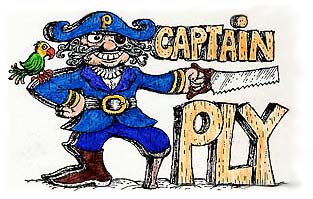
All sailing is actually solar-sailing, of course. Without the power of the sun to heat and move the wind around we'd be sitting at the dock in our sailboats for a pretty long time. But recently we've been playing around with a new kind of solar sailing that lets us get a lot more fun out of our sailboat than we were expecting. It uses PV -panels to charge gel-cells, which in turn drive the electric motor, which is mounted, on a pivot-down arm. -So we're just a tug on the release lanyard away from having instant, quiet power any time we want it.
There's nothing startlingly new in any of our components, but the layout is so quick and easy to use that it's taught us some new truths about electric motoring on the water. And the most surprising was that the more convenient and sure-fire we made the system, the less we seemed to use it. I'll explain.
We first came across this phenomenon on our 36-footer we made from composites. It had a bi-pod mast, a fully-battened, boomless mainsail, twin jib rigs on roller furling, kick-up lee-boards that tucked into little fender skirts, -and a whole lot of other experiments, some of which worked better than we expected, and others which didn't. The point is, with a sea-going test-bed like this, we were nervous as cats about how it would actually perform on launch-day. There were so many new systems to worry about, I didn't know where to start as I tossed and turned through the night before the launch. Finally, I tried to focus the worry on the most important thing I could think of: whether it would point to windward and claw its way off a lee shore in a stiff breeze.
We hadn't gone a quarter mile, after pushing off from the dock on launch day, before we were slamming into a stiff breeze up a narrow channel with big, flesh-eating rip-rap rocks waiting for us on the downwind side. It was time to see if she could claw off a lee shore, sure enough. A crowd gathered like vultures on the jetty to watch the bloodshed as we threw our fates to the wind and plunged in. Might as well get it over with right away, was the theory. Gradually the conversation went very quiet as every one of the crew, on his own, lined up a landmark with some part of the rigging to sight along and find out if we were gaining or losing (if we were going to crash or not). A boat-designer friend was on board and was particularly silent as we all nervously squinted and sighted. Finally we began to exchange tentatively hopeful glances. The boat was actually going to windward like a witch, and the boat designer admitted the big cat was pointing better than his monohull would have. Relief poured out in the form of celebration beers and we toasted our bright new boat and waved to all the nice people on the jetty who kept waving back more and more as we plowed to windward. They were trying (we found out a few moments later) to warn us that we were shooting straight for the mud flats after missing the turn in the channel. We found out soon enough when everything ground to a sudden stop. Trying to look as unflustered as possible, we lowered the two electric motors on their swing-down arms so they could propel us to hell out of there. They did this, bouncing obligingly along the bottom until we got free. Instant electrics to the rescue!
The next test on my list of ordeals was to see how well this new rig layout on top these new hulls would tack into the wind. I threw over the helm, she started making her U-turn, and then stopped right in the middle. We frantically backed the jibs, shouted a bit and got her underway again, -going the same way we were before. It might take some careful sailing to get this boat to tack I began to realise. We tried again, more carefully this time, and failed again. We tried this system and that theory, but nothing seemed to do it. We tried everybody shouting at once, we tried making each guy captain so his timing instincts could be followed down to the second, we tried swinging wide, we tried cutting it sharp. Whatever we tried, the results were the same. It would swing her noses up into the wind and then stop and sit there bobbing like a brainless hobbyhorse. We could "wear ship" and go around the other way, of course. But that was embarrassing and took up a lot of harbor. So, finally I pulled the lanyard and dropped the motor on the downwind hull, turned it on, she zapped around pretty as you please, and we took off on the next tack. Since both the lanyard and the twist throttle were hidden away sort of out of sight, it was a very discrete maneuver. In fact, if you pointed out some landmark of interest while you were doing it, even people on board were unaware that you were using the motor to tack the boat (or "Power-tack", as we called it, to give it a touch of legitimacy).
We got used to power-tacking, and eventually got so brazen about it that we'd sally right on up in the lee of a parked aircraft carrier until we could read the bosun's newspaper, then quietly drop the motor, zip around, and shoot out of there like we knew what we were up to. Following one of these show-off tacks I was gathering my wits while the sails were quieting down after the tack, when I realised that I hadn't raised the motor. I went to pull on the lanyard, and saw that the motor was already up. I asked who had raised the motor, but nobody came clean. Then I looked at the motor and saw it was dry. I'd not only forgotten to raise it, -I'd forgotten to use it at all. But somehow the boat had tacked! Curious looks of awe stole across our faces as we, one by one, realised what this meant. The boat, for the first time in its career had made a clean and neat tack, -and nobody had even noticed it.
That, it turned out, was the system. The boat would tack only if you were concentrating on something else altogether. We tried it again, pulling into a tack, and then getting into a deep conversation or studying the scenery really hard, -and the boat tacked like clockwork. But the point of all this is that we never would have learned how to manage the boat if we hadn't had a very convenient, and ultra dependable motor system that we could sort of forget existed, -until we didn't need it anymore.
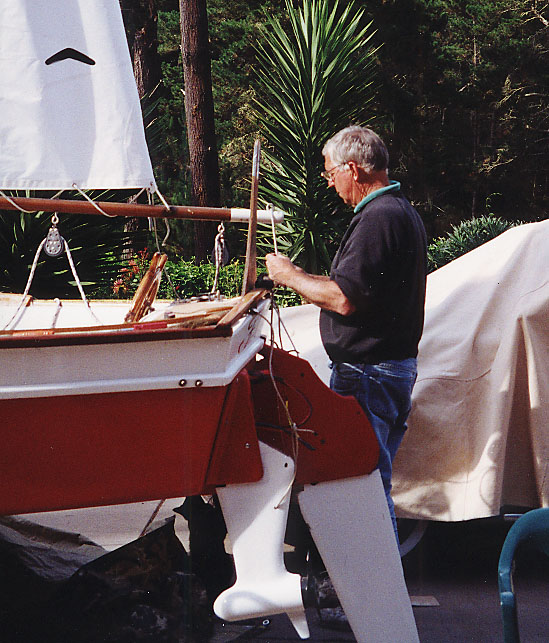 Later we tried putting a similar, scaled-down version of the swing-down electric power unit on our little 16-foot friendship sloop, the "Weekender." It's an easy boat to tack or do about anything with, but we thought we'd make it a little more convenient to get on the trailer by sticking the same sort of electric set-up we had on the 36-footer.
Later we tried putting a similar, scaled-down version of the swing-down electric power unit on our little 16-foot friendship sloop, the "Weekender." It's an easy boat to tack or do about anything with, but we thought we'd make it a little more convenient to get on the trailer by sticking the same sort of electric set-up we had on the 36-footer.
Again, we rigged it on a faired-strut that could swing down when we released a lanyard. The throttle this time was run by foot, which made cheating with electric power even harder to spot by the guys you leave behind, fiddling with their sails to make their boats go straight upwind like ours.
Eventually, as you'd expect, we began to use this ultra quick and convenient set-up for other maneuvers than just docking. If there were a particularly expensive boat we wanted to leave in the dust (courtesy of the quiet electric afterburner), or if everybody else was having to tack back and forth up a long, narrow channel, we'd just suddenly move out in the right direction with angelic looks on our faces.
But most of all, we liked the thought that with absolutely no fuss, noise, or embarrassment, in an emergency we could get a magic push in the right direction in seconds. It made us into bold sailors, unafraid of currents under bridges or approaching destroyers. And the curious thing was that, with this extra measure of confidence, -we hardly ever actually had to use the motor. The extra ace in the hole was making us sail more confidently and challengingly. As a result, we were getting into fewer and fewer botched situations, -and eventually learning to sail reasonably smoothly out of all sorts of tight spots, -enjoying not using the motor.
With a power system that takes absolutely no time to put into action, you don't have to fire it up the minute a threat appears on the horizon just to make sure it'll be warmed up and ready to use in time. You can put it off, and see what develops. And then you find out nine time out of ten that you don't need it after all. If you had to fire up early, you'd go ahead and use it, to be on the safe side (since it's already running and it's silly not to use it once it's running), -and then never find out the way to sail out of the situation.
Another advantage we really enjoy about solar sailing is that now we can go evening sailing, riding those last zephyrs of twilight when the water's calm; -without having to row home, -or having to start up a balky, smelly, noisy outboard to ruin the mood.
We wanted to make the charging system easy and convenient too, so we used the same sort of solar-panel/charge controller system we used on the big boat. On it we had sixteen 51-watt panels, so everything always seemed to be charged up. In fact, once the batteries were charged, we were just throwing away solar power if we didn't turn on the stereo, the blender, the lights, and everything.But there was no space on the little friendship for panels so we rigged two on a folding frame for use when the boat was parked at anchor or in the driveway. With our previous little 12' solar-power catamaran bass-boat, we found the charge level to be almost always a pleasant surprise. We couldn't figure this out until we started looking at it as a ratio between actual minutes sitting in the sun (in the driveway, on the freeway, stopping to get doughnuts, etc) to the actual minutes of use. Then we began to see why we could trim down from four to two panels on the little powercat and still have plenty of battery charge. On a sailboat, the ratio is a joke. If you're sailing most of the time and hardly ever using the motor, the panels will keep the batteries up with no problem just hooking them up once in awhile in the driveway. And the charge controller makes it a lot easier than using an auto battery charger to "tank-up."
We stuffed a couple of gel-cells on their side under the cockpit seats for a 24 volt system, which has plenty of punch and is well within the Coast Guard's 50-volt limit for boats. (Ed.Note: See the Cap'n Ply article on ballast to see about moving the batteries forward) We used a 45-pound thrust trolling motor which has more than enough push for sailboats under twenty feet. We removed the motor controller handle and cut the mounting pipe. Then we glassed tapered 1x4"s to the front and rear of the pipe to fair it in and provide a pivot hole. It's important to fair in this pipe because it has terrific drag at sailboat speeds without the fairing We drilled a hole through one of the seat-fronts near the bottom and poked the control handle through this so we could kick it into action with a flick of the toe.
The stock prop for the trolling thruster turns out to be pretty usable. It has a lot of take-out torque if you need to get out of trouble, but then it tends to plateau at about 4-5 knots. You lose a higher top speed that the motor could pull, but you get good efficient running at very usable speeds. And the electric power system does make it a snap to get it onto the trailer too (the reason we put it on in there first place). We think this simple solar/electric system can make any sailboat into a machine you simply won't hesitate about going anywhere with. Plus, with the solar panel recharge, you're still cruising on the quiet power of the sun, even when the sails are down.
Cap'n Ply
We like the trolling motors from MotorGuide and Mercury, but MinnKota also seems to be pretty good. There are some saltwater-approved electric motors around, so you might want to look for those. We've had a fair amount of time to play with solar panels, and recommend Kyocera solar panels or Siemens. The Kyocera panels are poly-crystalline, which is not quite as efficient as mono-crystalline (like the Siemens), but less expensive to make. The Kyocera panels have an anti-reflective coating on the cells themselves, which helps let in more light (more power!). The newer Siemens panels are laser cut with some sort of surface treatment to let more light in the cells; sounds good. Kyocera has the best warranty in the industry (or it has had; I haven't checked recently to see if other companies have tried to follow suit): If one of your panels loses 10% of its power output in 10 years, they'll give you a new panel! They also were one of the only panels which put out slightly more than the rated output. Kyocera first choice if they're cheaper than the Siemens, Siemens if the price is close.
We have had good luck with Trace charge controllers. They're overbuilt, reliable, and user-adjustable to suit battery types. There are a lot of good controllers on the market now, so this is a good point to research. West Marine sells some pretty good-looking controllers, but take a look at Trace as well.
Use good marine-grade wire! West sells Ancor wire which is good tinned-copper (copper which has been tinned with zinc for much less corrosion). Don't use untinned if you can help it; the creeping black copper-rot will slowly work its way up the wires and cut the capacity dramatically. (One reason boat trailers have lots of wiring trouble) We like to crimp connections using uninsulated fittings (tinned if available), then give the assembly a quick hit of solder to increase current carrying capacity. Don't over-do the solder to the point where you stiffen the wire. That will make wires susceptible to vibration failure (or more likely: failure due to wiggling the wire around when installing). Just enough to get the electrons into or out of the wire easily...
Make your wire sizes BIG. The charts which are in West Marine catalogs are on the small side, especially for motor-feed wires. Use the charts, then go one size bigger.
Our top-pick for batteries are lead-acid gel-cells. We started out using these about 1989, and haven't found a battery we like better yet. We used to use the Sonnenschein gel-cells from Germany, but then they licensed their technology to supply West Marine. The West gel-cells are the kind we get now. (Although the very first German batteries lasted longer and had better energy capacity than the US-made versions) Optima batteries are pretty good too, and I suspect that the other starved-electrolyte-AGM-type batteries West sells would probably work fine as well. We no longer use wet lead-acid "trolling motor batteries" as they can't be tipped on their sides, they need water, and they don't have nearly the energy efficiency and long life that gel-cells can give.
Trolling motor props: slow but lots of torque. In other words, good for sailing. When we were using these type of motors on powered catamarans, we wanted more speed. In the solar-sailing arena, we want good pulling power and gentle battery use. Standard trolling motor props work well as they have good pull but top out at about 4.5 knots and consequently lower your amp-draw on the batteries.
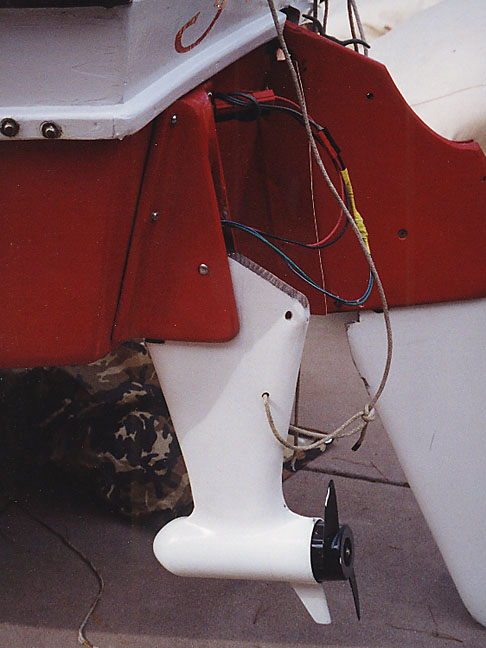
The photo above shows the bracket we made to hold the motor. It's just plywood and a bit of 2X2. We can release the line and drop the motor very quickly; it only takes a few seconds to drop the motor and turn on the motor. The only big drawback in this set-up is that there's no provision for reverse, as the motor will just back up out of the water. We haven't found this to be a problem in practice. The trolling motor is modified thusly: Take off the control head, mount that somewhere handy and extend the wires as needed (Take note of the larger wire recommendation above, and also the quick-disconnect plug in the photo above for storage). The trolling motor and its pipe are faired in with a handy core material; we've used both urethane foam and redwood in our motor conversions. Bondo-type material for sticking things together and fairing before and after glassing. If you're an epoxy-prone builder, then you'll be using that. Glass the motor assembly but keep in mind this is an aesthetic and hydrodynamic job; the motor's plenty strong enough on its own. We have tried to avoid, as much as is convenient, bondo-ing and glassing the motor housing itself as they usually rely a fair amount on the water they're immersed in for cooling.
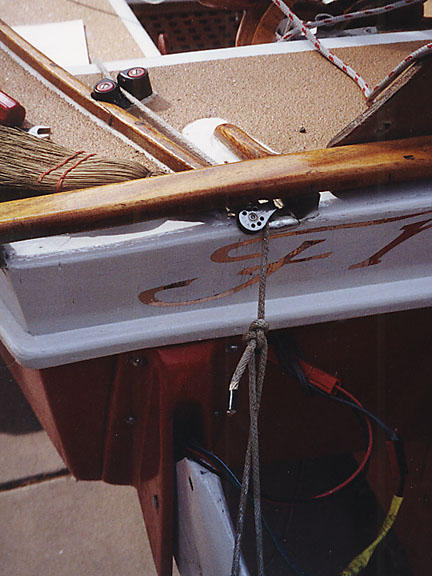
This shot shows the rope details for holding the motor out of the water when not using it. The jam cleat is very quick, both when raising the motor or dropping it.
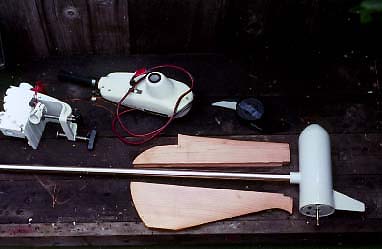 In this photo one can see the major components of the trolling motor conversion.
In this photo one can see the major components of the trolling motor conversion.
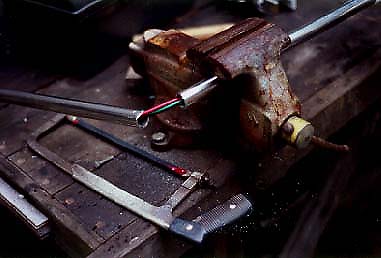 When cutting the pipe, be sure you don't cut the wires inside! Be careful also of the freshly cut pipe, as it will cut you and/or the wires as easily as the saw will.
When cutting the pipe, be sure you don't cut the wires inside! Be careful also of the freshly cut pipe, as it will cut you and/or the wires as easily as the saw will.
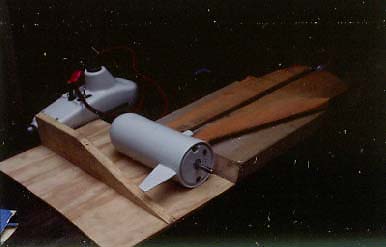 Here the motor is propped up and the farings are held with bits of wood so that they're parallel and at the right height. Bondo will be used to hold the fairings and smooth the assembly until glass is added. Epoxy people will no doubt be using something other than bondo.
Here the motor is propped up and the farings are held with bits of wood so that they're parallel and at the right height. Bondo will be used to hold the fairings and smooth the assembly until glass is added. Epoxy people will no doubt be using something other than bondo.
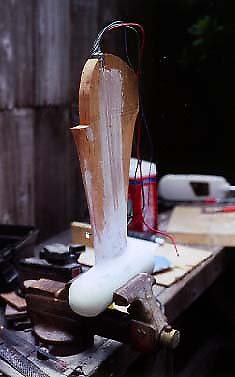 This shot shows the fairings and how they are blended into the motor.
This shot shows the fairings and how they are blended into the motor.
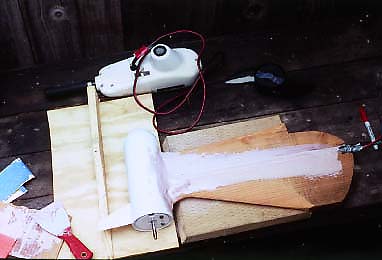 An overhead view.
An overhead view.
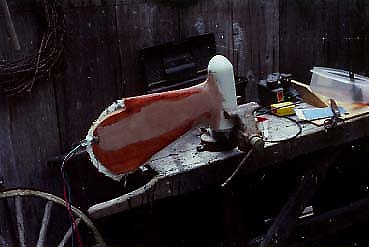 Fiberglass covering the new parts. This will be bondoed (or smoothed in whatever form you use), then painted and drilled for a pivot point as needed by the mount you make. The wires will be lengthened and quick disconnects will be used to allow for removal of the motor when trailing, etc. Mount the motor head (the controller part) where it's most convenient for you. We have ours under a seat, poking out into the foot weel area, but we've modified the twist grip so that it has a lever we can kick with our feet to set the boat in motion. This may be far too awkward for some people, but it serves as an idea of how just about any arrangement can work.
Fiberglass covering the new parts. This will be bondoed (or smoothed in whatever form you use), then painted and drilled for a pivot point as needed by the mount you make. The wires will be lengthened and quick disconnects will be used to allow for removal of the motor when trailing, etc. Mount the motor head (the controller part) where it's most convenient for you. We have ours under a seat, poking out into the foot weel area, but we've modified the twist grip so that it has a lever we can kick with our feet to set the boat in motion. This may be far too awkward for some people, but it serves as an idea of how just about any arrangement can work.
Have fun!
![]()

Copyright 2024 Stevenson Projects LLC